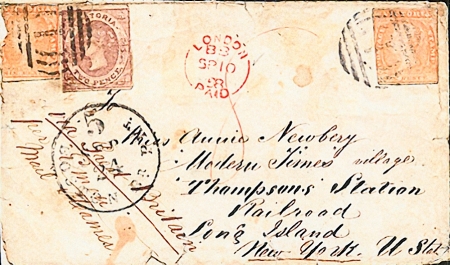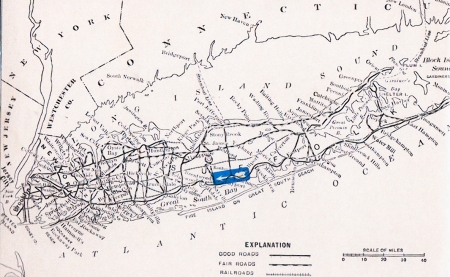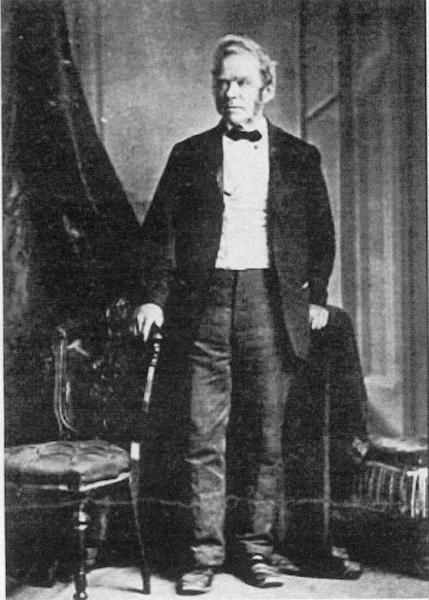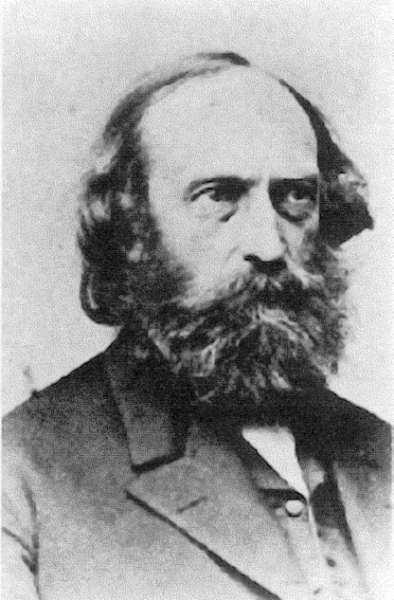This cover was mailed from Melbourne on July 15, 1858 franked with two copies of the orange 6d imperforate ‘Woodblock’ stamps as well as a single lilac 2d ‘Emblems’ stamp of Victoria cancelled with the barred numeral ‘1′ of Melbourne. There was a red manuscript rating of ‘8′ and an obliquely placed manuscript ‘via Great Britain/ per Emeu/ Mail Steamer’ as well as a red handstamp LONDON/ 88/ SP 10/ 58/ PAID. In addition there was a large black handstamp of 5/ SP/ 24/ BOSTON BR. PKT. The cover was addressed to Miss Annie Newbery, Modern Times village, Thompsons Station Railroad, Long Island, New York, U Stat, written in a copperplate style (Figure 1).

The reverse unfortunately did not have an arrival handstamp on Long Island N.Y., the flap was sealed with red wax and there was an originating postmark of ( )/ MELBOURNE/ JY – 15/ 58, and the addressee was neither identified on the front nor on the reverse (Figure 2).
The address was as intriguing as the stamps, the several postmarks, the manuscript markings and the penmanship of the sender. There was limited information on the internet until I entered the Brentwood Public Library, which was a cornucopia of information on the address, and possibly the addressee. The Long Island address was short lived for it was incorporated into the town of Brentwood in 1864. In a map of Long Island circa 1900, the Island is shown stretching from Brooklyn in the west to Montauk in the east, separated by the Long Island Sound from New Jersey, New York and Connecticut, with the Atlantic Ocean along its other side. The position of the town of Brentwood is indicated by the blue arrow (Figure 3).

There were two founders of the Modern Times village, Josiah Warren and Stephen Pearl Andrews. These two remarkable men late in the year of 1850, stepped off a Long Island Railway train at Thompson’s Station and walked along the railway track to the site of the entirely uninhabited site of the future Modern Times village. After inspecting the area they arranged to purchase 750 acres of which 90 acres was set aside for the main settlement. The village was in existence from 1851 until 1864 and its population never exceeded 150 inhabitants. Thompson’s Station had been established in 1842, and it served as a railroad depot, which had a post office in 1849, plus a general store and an inn. In 1869 the railway depot at Thompson’s Station was closed and moved to the centre of Brentwood.
Josiah Warren (1798-1874) was born in Boston and died in Charleston, Mass. and was the guiding light of the “free love” colony of Modern Times. He was a reformer and anarchist, a philosopher and inventor, but a gentle and non-violent anarchist. He was an early follower of Robert Owen, but he rejected the latter’s political socialism, advocating instead an anarchy based on “the sovereignty of the individual”. Of the three utopian colonies which he founded, Modern Times was the most successful. Warren placed an advertisement ( A Card to the Public) printed in Horace Greeley’s New York Tribune in January 1851 setting forth the advantages of an ideal community. A picture of Josiah Warren is seen in Figure 4.

In his Long Island venture, Warren had the assistance of Stephen Pearl Andrews, the brainiest of the “free lovers” and he was described at the time as “the brainiest man on the globe”. He was a reformer, author, linguist (speaking 6 or more fluently with a working knowledge of 34 others!), philosopher and ardent abolitionist. He was an unconventional lawyer and an ardent women’s right advocate. A picture of Stephen Pearl Andrews is seen in Figure 5.

One of the cast of individuals who inhabited the Modern Times community was Edward Newber(r)y, an original settler, a dentist, homeopathic physician, phrenologist, scientist, writer, painter, interior decorator, a healer, social reformer, advocate of free-love, large families, as well as an advocate of “Human Perfectibility”. His dental office was in New York City and he commuted between his office and Newber(r)y House located in the Modern Times village. He carried various medicines in his hollowed-out cane which he took with him on his walks in the village. The Newber(r)y family were prominent in the village as well in the future Brentwood town, and one wondered if Miss Annie Newbery’s name on the cover had been misspelled. However in A Century of Brentwood by Verne Dyson (1950) Newbery was spelt with one ‘r’. He was born in London, England on February 12, 1811 and was 19th in a family of 37 children, and first of Newbery senior’s second wife. He was first schooled in Belgium and later went to Paris for advanced study.
He was described as highly skilled in medicine, learned in chemistry, botany and zoology and successful as an artist. He developed a theory for improving the human race by scientific cross-fertilization (stripticulture) instead of the usual haphazard method of propagation. He came to the United States at the age of 23, from France by way of South America and he met the social reformers Warren and Andrews in New York and learned of the colony of Modern Times where he bought a plot of land on which was built Newbery House. Three of his sons went to Argentina and became wealthy and he also had a daughter, Rose. He went from Brentwood to Brooklyn, N.Y. where he died on April 16, 1887.
Josiah Warren left Modern Times shortly before the name of the village was changed to Brentwood in the troubled Civil War period, his last years spent aimlessly in and around Boston. During his life he published Equitable Commerce in 1846, True Civilization an Immediate Necessity in 1863, and posthumously in 1875, True Civilization.
Addendum: The date of this cover could be in dispute, either 1858, 88 or 98. However, 1858 is the most likely, for the following reasons: The Modern Times village was in existence from 1851 until 1864 (very well documented); Thompson’s Station closed down in 1869 (moved to Brentwood, Long Island, also documented); The issue date for the wood block and emblem stamps was ca. 1857; The S.S. Emeu was launched in Glasgow in 1853 and was on the Australian run in 1854, damaged in 1857 and stranded in Red Sea, but resumed 11.3.1858 from Sydney; and, the vendor stated the date was 1858.
In the 1860 U.S. Census, Edward Newberry of Islip Suffolk County was aged 48 years and Anna Newberry at the same address was aged 16. Thus in 1858, the time of the cover, she was aged only14 years.
I am indebted to Mary Koferl, Librarian, Suffolk Library New York for her enthusiastic research, particularly for providing the information on Dr. Edward Newbery and her tireless endeavours to find Annie Newbery.